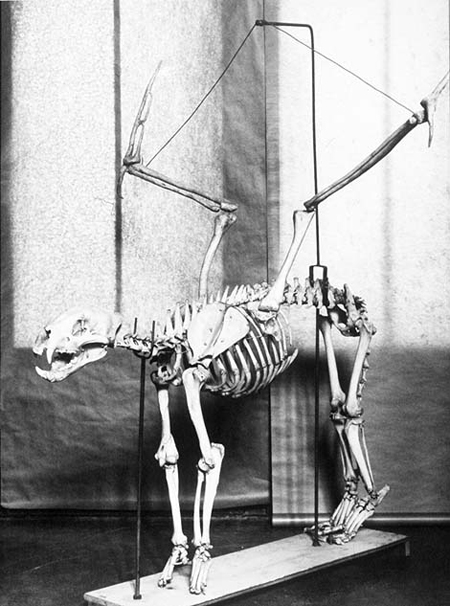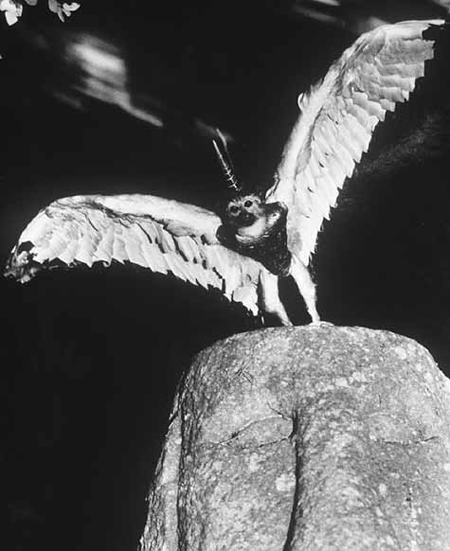Joan Fontcuberta & Pere Formiguera
Felix Penatus, 1987
Joan Fontcuberta´s and Pere Formiguera´s work Fauna is the Natural History of imagination. It consists of an Archive of impossible but possibly existing animals – hybrids and meta creatures.
The collector of the Archive is Dr. Ameisenhaufen, the Alter Ego of the artists. These pictures are a part of a series of Fauna consisting of dozens of different animals. All the animals have been originally “reconstructed” in their natural size.
Solenoglypha Polipodida, 1987
Phylum: Chordata
Subphylum: Vertebrata
Class: Reptilia-Ratidae
Sighting: Found in a deciduous forest in the federal state of Tamil Nadu in southern India,
thanks to informant G-16, who was attacked while looking for truffles. Observation and capture lasted for a period of 30 days, during which it proved impossible to locate any othe} specimen. Survived in captivity until it was killed by artificial means to allow study of its internal structure.
Date of Capture: 30 April 1941.
Main Traits: Osseous internal skeleton. Pulmonary respiration. Typical vertebrate nervous system. It has not been possible to observe its reproductive system, but everything would indicate that it is oviparous with division of the sexes. The captured specimen is an adult male measuring 133cm in length.
Morphology: Corresponds to a mixture of reptile and non-flying bird. Although it has no wings now, it is quite possible that more primitive forms did have them. The morphological characteristics correspond completely to those of report 21 on the postRellic fauna of Mobolk, provided by Dr. Ray’s liaison. It would thus correspond to suborder 8 of the current New Zoology.
Habits: Extremely aggressive and venomous, it hunts for food and also for the pleasure of killing. It is quite rapid and moves forward in a curious and very rapid run, thanks to the strong musculature of its 12 paws and the supplementary impulse which it obtains by undulating all of its body in a strange aerial reptation. When facing its prey it becomes completely immobile and emits a very sharp whistle which paralyzes its enemy. It maintains this immobility for as long as the predator needs to secrete the gastric juices required to digest its prey, which can vary between two minutes and three hours, as determined by the size of the victim. At the end of the whistling phase, Solenoglypha launches itself rapidly at its immobile prey and bites the nape of its neck, causing instantaneous death. Immediately afterwards, if it wishes to eat its victim, the beast vomits part of the gastric juices all over the animal and waits for this highly acidic matter to begin to take effect, while it circles around the dead animal uttering the characteristic murmur of “Globe-toe,” with a 3-pause-1 cadence. Unlike known reptiles, Solenoglypha never rests after eating. Quite the contrary, it sets off on a wild chase which is only interrupted for the purpose of defecation.
Cercopithecus Icarocornu, 1987
Phylum: Chordata
Subphylum: Vertebrata
Class: Mammalia
Sighting: Found in the Amazon jungle (Brazil) with the aid of the eminent anthropologist Dr. Edson Nelinho, who discovered it while carrying out studies on the Nygala-Tebo tribe. Once in Brazil, accompanied by Dr. Nelinho, whom the primitive tribes consider to be semi-divine, and my assistant Hans, I lived among the NygalaTebo for 12 days, observing the curious behavior of this extraordinary animal.
Dates of Observation: 28 February to 11 March 1944.
Main Traits and Morphology: It is a long-tailed simian with large wings which turn it into an animal eminently suited for flying. Its morphology apparently corresponds completely to that of a mammal and has nothing to do with a bird’s. At any rate, the close vigilance to which the natives subjected us prevented me from carrying out any detailed observation of the animal. From what I could observe, it is omnivorous with an indiscriminate diet of insects, fruit and small animals which it hunts in full flight with its long and resilient barley sugar horn. It would correspond to suborder 6 of the current New Zoology.
Habits: Cercopithecus Icarocornu is the sacred animal of the indigenous Nygala-Tebo tribes, for whom it represents the reincarnation of Ahzran (he who came from heaven). The females give birth inside a large cabin in the village to which only the great shaman has access. The baby animals remain inside the cabin until they have completely developed their ability to fly, at which point the tribe celebrates a lavish ceremony during which Cercopithecus undergoes an operation in which it is grafted with the skin of the silver fish of the Amazon, which covers all of the pectoral and abdominal zone. Once this has been done, the animal is set free, although it never strays very far away from the village, and participates by its presence in all of the sacred festivals of the NygalaTebo. During these festivals the animal is given a spirituous beverage which it drinks eagerly, sinking into a state of complete inebriety, at which point it begins to flap its wings so madly that it hovers in mid-air with its body immobile, singing like one possessed. Its song is strangely husky and deep, given its small size, and it articulates a series of sounds which constitute a kind of psalmody which the natives seem to understand and to which they listen with great attention. The sexual act occurs inside the cabin, which is also the place where the elderly take refuge when they feel that death is near.


